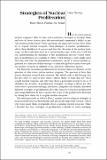| dc.contributor.author | Narang, Vipin | |
| dc.date.accessioned | 2017-06-19T18:50:47Z | |
| dc.date.available | 2017-06-19T18:50:47Z | |
| dc.date.issued | 2017-02 | |
| dc.identifier.issn | 0162-2889 | |
| dc.identifier.issn | 1531-4804 | |
| dc.identifier.uri | http://hdl.handle.net/1721.1/110018 | |
| dc.description.abstract | How do states pursue nuclear weapons? Why do they select particular strategies to develop them, and how do these choices affect the international community's ability to prevent nuclear proliferation? The bulk of the proliferation literature focuses on why states want nuclear weapons. The question of how they pursue them, however, has largely been ignored. This question is important because how states try to acquire nuclear weapons—their strategies of nuclear proliferation—affects their likelihood of success and thus the character of the nuclear landscape. Four strategies of proliferation are available to states: hedging, sprinting, hiding, and sheltered pursuit. Nuclear acquisition theory explains why a proliferator might select one strategy over the others at a given time. Empirical codings from the universe of nuclear pursuers, combined with a detailed plausibility probe of India's long march to acquiring nuclear weapons—including novel details—establish the analytical power of the theory. Different strategies of proliferation offer different opportunities and vulnerabilities for nuclear proliferation and nonproliferation, with significant implications for international security. | en_US |
| dc.language.iso | en_US | |
| dc.publisher | MIT Press | en_US |
| dc.relation.isversionof | http://dx.doi.org/10.1162/ISEC_a_00268 | en_US |
| dc.rights | Article is made available in accordance with the publisher's policy and may be subject to US copyright law. Please refer to the publisher's site for terms of use. | en_US |
| dc.source | MIT Press | en_US |
| dc.title | Strategies of Nuclear Proliferation: How States Pursue the Bomb | en_US |
| dc.type | Article | en_US |
| dc.identifier.citation | Narang, Vipin. “Strategies of Nuclear Proliferation: How States Pursue the Bomb.” International Security 41, no. 3 (January 2017): 110–150 © 2016 Massachusetts Institute of Technology | en_US |
| dc.contributor.department | Massachusetts Institute of Technology. Department of Political Science | en_US |
| dc.contributor.department | Massachusetts Institute of Technology. Security Studies Program | en_US |
| dc.contributor.mitauthor | Narang, Vipin | |
| dc.relation.journal | International Security | en_US |
| dc.eprint.version | Final published version | en_US |
| dc.type.uri | http://purl.org/eprint/type/JournalArticle | en_US |
| eprint.status | http://purl.org/eprint/status/PeerReviewed | en_US |
| dspace.orderedauthors | Narang, Vipin | en_US |
| dspace.embargo.terms | N | en_US |
| dc.identifier.orcid | https://orcid.org/0000-0002-0693-6008 | |
| mit.license | PUBLISHER_POLICY | en_US |
| mit.metadata.status | Complete | |
